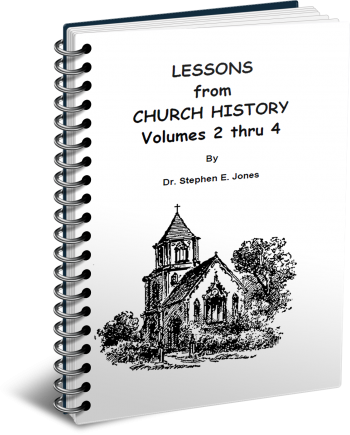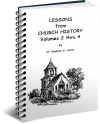Latest Posts
View the latest posts in an easy-to-read list format, with filtering options.

Volumes 2-4. This is the history of the Church from the Roman War (66-73 A.D.) to Constantine and the Council of Nicea in 325 A.D. with lessons to be learned from it.
Category - History and Prophecy

The biblical story of King Saul tells us about the problems that would later develop in the Church. I mentioned three of the main ones: (1) Saul usurped the position of priest and/or prophet by making the sacrifice himself when he was not called to do this; (2) his rash religiosity caused the people to become bloodthirsty; and (3) he failed to judge the people by the mind of God and instead judged according to his own understanding and faulty reasoning.
To these, a fourth characteristic can be added—he refused to submit to the divine judgment when he was disobedient. Thus, when God forsook him, he valued what the people thought of him more than what God thought (1 Sam. 15:30, 31). Samuel told him that he was in a state of rebellion against God and said the famous maxim, “rebellion is as the sin of witchcraft” (1 Sam. 15:23).
Witchcraft is the attempt to manipulate and override the will of another by unlawful means. It is the attempt to force one's own will upon another and thereby violate the personal integrity of another. That is why witchcraft spends its time casting spells and curses upon others, which have a very real effect on people. I know, because I experience these on occasion and have to take action against them in the Divine Court.
Saul rebelled by using his God-given authority in ways that were contrary to the will of God. In effect, he believed in the principle of rex lex, “the king is law.” From this was derived the doctrine of “the divine right of kings” to do as they saw fit, thinking that God would back them up in every decision they made just because He had chosen them to rule.
That is the heart of rebellion, and out of that idea came the view that rulers have the right to make their own laws which are manipulative by nature. God's law is a healing balm of Gilead, but man's laws are opium (mistakenly called “wormwood” in Jer. 9:15). Hence, Amos 5:7 speaks of “those who turn justice into opium.” Opium masks the pain, but does nothing to heal the original problem. It speaks of religion that counterfeits the true healing and health that God offers.
Saul began in rebellion and ended by consulting the witch of En-dor (1 Sam. 28:7). This, too, prophesies of the Church, and for this reason, Karl Marx observed that “religion is the opiate of the people.” Frank Baum said the same thing in a different way in The Wizard of Oz, where Dorothy (the Church) had to walk through the poppy field (opium) to get to the Emerald City. She and her friends, of course, fell asleep in the poppy field, even as the Church has fallen asleep in its blindness until the time of the end.
Church history is largely the study of how Christianity came to become a religion, following the prophetic pattern of King Saul, who is the primary type of the political Church. We also have a secondary prophetic pattern of Eli, the rebellious high priest, who forms the primary pattern of Church Priesthood.
Saul usurped a priestly role by offering the sacrifice and not waiting for Samuel to arrive. His excuse was “because I saw that the people were scattered from me” (1 Sam. 13:11). He was more concerned about UNITY than obedience. The Church followed this pattern beginning as early as the second century with the rise of “heresies.” The last of the apostles had died, and the Church then lacked an authoritative voice by which to judge new ideas, concepts, and viewpoints in the natural development of Christian doctrine. And so the great concern was the unity of the Church.
The problem was that increasingly the idea of the “Church” came to be thought of as the visible form and structure, rather than being based upon the invisible relationship that men had with Jesus Christ. This subtle change caused the bishops to start down the path that ended with Cyprian (who died in 258) claiming that the bishops were in the church and the church in the bishops. In other words, a person was not a Christian (i.e., not part of the Church) unless he was in unity with and submitted to the bishop. And it did not matter how corrupt the bishop was, for such corruption was thought to be hardly relevant to the issue.
In other words, the bishops adopted the rex lex view of King Saul. Form and structure now defined the word “Church,” making one's relationship with Christ dependent upon one's membership in the visible Church—that is, the bishop. The visible thus became subject to the invisible, for the bishop had usurped the power over men's souls to determine their very salvation. Somehow God was expected to rubber stamp the bishop’s decision determining men’s relationship with God.
The second sin of Saul listed in the Bible was when he made a rash vow, forbidding anyone to eat during the heat of battle. When the people were finally allowed to eat, they rushed on the food and ate it with the blood in violation of the law (Lev. 17:14; Acts 15:20). Saul's religiosity made the people blood-thirsty, and that is how it was fulfilled in later Church history. As the Church increasingly lost its Sword of the Spirit, it increasingly trusted in the physical sword. This phase of Church history began with the Sword of Constantine, which came to be identified with the cross in the early fourth century.
In the story of Saul, we find that his son Jonathan had not been informed of his father's vow and had eaten some honey (1 Sam. 14:27). The verse says that “his eyes were enlightened” by the honey. Jonathan was a type of overcomer in the house of Saul, one who was not blind to the truth. The honey represents the Gospel of the Kingdom (the “land flowing with milk and honey,” Ex. 3:8). There have been many in the house of Saul over the centuries who are represented prophetically by Jonathan. There is a certain element of tragedy in this, for Jonathan was torn between his love for David and his loyalty to his father.
Saul was ready to kill Jonathan for violation of the rash vow (1 Sam. 14:44), but the people prevented it. Even so, Saul's zealous religiosity came to full fruition when he tried later to kill David. Saul believed that God expected him to defend his throne at all costs. In like manner, the Church came to think of its defense as the prime directive. What began with excommunicating heretics in the second century increased to killing heretics in the fourth century. Finally, in later centuries the Roman Popes assumed a political role as King of Kings and sought physical territory to rule directly with an actual army (These were called the Papal States.)
If the Popes (and the bishops of the earlier Church) had retained the mind of Christ and had submitted to Christ in men, rather than to men supposedly in Christ, they would not have fallen into the error of Saul. If they had viewed their positions of authority as a calling to rule as Christ would have ruled, instead of assuming that Christ submitted to human decisions, they would not have usurped the throne of God and become biblical antichrists. But they did not do this.
Even so, to put it into perspective, it was prophesied in the Old Testament in the form of types and shadows. Saul was power hungry, and Eli would not correct his sons. These types find their fulfillment in the Church as it developed into a religion.
Finally, we cannot simply blame the Church hierarchy, for they would not have fulfilled the patterns of Saul if the people themselves had not demanded it. Saul was made king at the demand of the people (1 Sam. 8:5). The people thought that God was too hard on them and did not understand human nature. So they got their king who was just like them, but soon discovered that a king like them was a “taker” (1 Sam. 8:11-17).